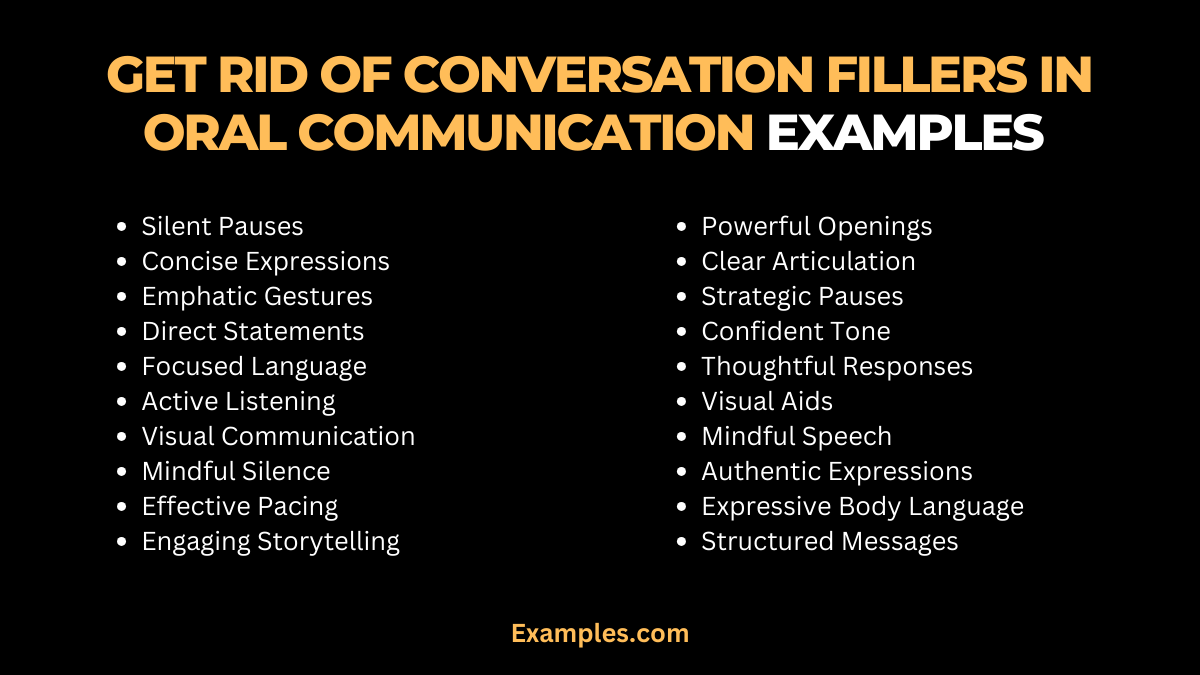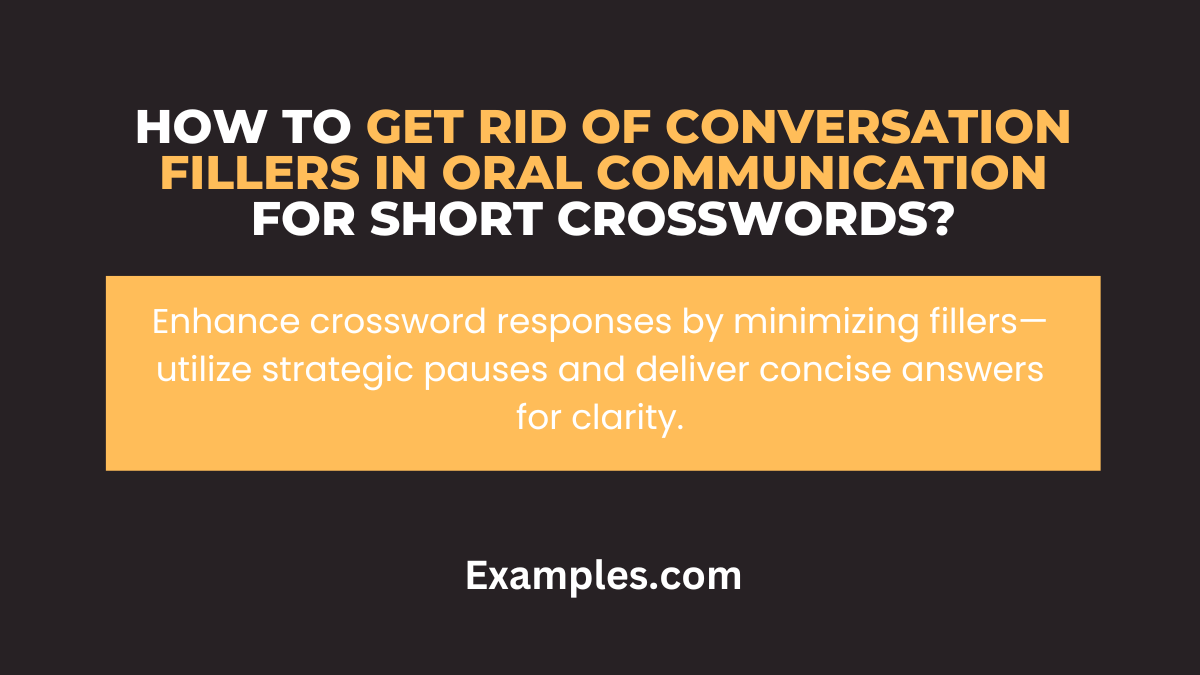19+ Get Rid Of Conversation Fillers In Oral Communication Examples
Are you ready to enhance your oral communication by eliminating those pesky conversation fillers? This comprehensive guide dives into practical strategies, providing real-life examples to transform your speech. Discover effective tips and tricks to convey your message with clarity, leaving a lasting impact.
20 Get Rid Of Conversation Fillers In Oral Communication Examples

Enhance your communication by eliminating fillers! Explore practical examples to refine your speech and leave a lasting impression. Discover valuable tips for effective and assertive oral communication.
- Silent Pauses: Embrace brief pauses for a more composed delivery, avoiding unnecessary fillers.
- Concise Expressions: Practice conveying ideas in clear and succinct sentences, reducing filler usage.
- Emphatic Gestures: Use purposeful gestures to supplement speech, minimizing reliance on fillers.
- Direct Statements: Express thoughts directly, eliminating the need for filler words like “um” or “uh.”
- Focused Language: Maintain clarity by choosing words carefully, reducing unnecessary fillers in conversation.
- Active Listening: Engage in active listening to respond thoughtfully, avoiding filler phrases in your replies.
- Visual Communication: Utilize visual aids to enhance understanding, reducing the need for verbal fillers.
- Mindful Silence: Embrace moments of silence to gather thoughts, preventing filler use in impromptu speech.
- Effective Pacing: Practice a steady speaking pace to minimize filler words and enhance coherence.
- Engaging Storytelling: Craft compelling narratives that captivate listeners, reducing filler frequency.
- Powerful Openings: Begin conversations with impactful statements, steering clear of unnecessary fillers.
- Clear Articulation: Focus on articulating words clearly, reducing filler use for improved comprehension.
- Strategic Pauses: Introduce intentional pauses for emphasis, diminishing reliance on fillers.
- Confident Tone: Speak with confidence and conviction, minimizing filler phrases in assertive communication.
- Thoughtful Responses: Take a moment to formulate responses, avoiding fillers during impromptu discussions.
- Visual Aids: Use visuals to convey complex ideas, reducing the need for filler explanations.
- Mindful Speech: Be conscious of filler words, enhancing the clarity and impact of your oral communication.
- Authentic Expressions: Be genuine in your speech, minimizing filler usage for a more authentic connection.
- Expressive Body Language: Leverage body language to convey emotions, reducing reliance on verbal fillers.
- Structured Messages: Organize thoughts coherently, reducing the likelihood of filler phrases in your speech.
Get Rid Of Conversation Fillers In Oral Communication Examples for Couples
Enhance your connection by eliminating conversation fillers in couples’ communication. Explore examples and tips for more impactful and meaningful conversations.
- Pauses for Understanding: In discussions, use purposeful pauses to let your partner absorb information before continuing.
- Shared Language: Develop a unique set of words or phrases with your partner, creating a shared language that reduces fillers.
- Reflective Listening: Engage in reflective listening, responding thoughtfully instead of relying on filler words.
- Expressive Nonverbal Cues: Use expressive gestures and facial expressions to convey emotions, minimizing filler usage.
- Turn-Taking Awareness: Be mindful of turn-taking, allowing each partner to speak without unnecessary interruptions or fillers.
- Emotional Check-Ins: Conduct regular emotional check-ins, providing a structured space for meaningful communication without fillers.
- Focused Storytelling: Share stories with a clear focus, reducing the need for fillers to explain complex narratives.
- Attentive Silence: Embrace comfortable silences during discussions, promoting contemplation over filler usage.
- Positive Affirmations: Express appreciation and affirmation directly, minimizing the need for filler words.
- Shared Goals Discussion: When discussing future plans, use clear language to avoid misunderstandings and filler phrases.
Get Rid Of Conversation Fillers In Oral Communication Examples for Identity Management
Refine your identity expression by eliminating conversation fillers. Explore examples tailored for effective communication in various identity contexts.
- Confident Self-Introduction: Start conversations with a confident self-introduction, setting the tone without filler words.
- Cultural Awareness Statements: Express cultural nuances directly, reducing the need for fillers to explain background information.
- Identity Goal Statements: Clearly articulate identity goals, minimizing the use of fillers when discussing personal aspirations.
- Assertive Boundary Setting: Communicate boundaries assertively, reducing filler usage when expressing personal limits.
- Clear Pronoun Use: Use clear and direct pronouns, minimizing filler words when discussing personal experiences.
- Purposeful Silence: Embrace purposeful silence when asked personal questions, allowing thoughtful responses without fillers.
- Authentic Storytelling: Share personal stories authentically, reducing the need for filler words to convey emotions.
- Articulate Values: Clearly express personal values, minimizing filler usage when discussing belief systems.
- Mindful Identity Labels: Choose identity labels intentionally, reducing the need for fillers to explain one’s self.
- Direct Expression of Emotions: Express emotions directly, reducing filler words when discussing personal feelings.
What are Get Rid Of Conversation Fillers In Oral Communication for Short Crosswords?

When solving short crosswords, effective oral communication plays a crucial role. Eliminating conversation fillers ensures concise and clear responses. Utilize brief pauses strategically and practice delivering succinct answers, enhancing your crossword-solving experience. This fosters efficient communication, both verbal and written, as you convey thoughts with precision.
What is Included in Get Rid Of Conversation Fillers In Oral Communications?
In the journey to eliminate conversation fillers, key elements include adopting a purposeful and confident tone. Embrace clear articulation and strategic pauses, minimizing the use of unnecessary filler words. Incorporate nonverbal cues, such as expressive gestures, to supplement your message. Additionally, focus on concise sentence structures to convey ideas without relying on fillers.
Tips for Effective Get Rid Of Conversation Fillers In Oral Communications
- Visualization Communication: Picture your response before speaking to reduce reliance on fillers.
- Mindful Silence: Introduce purposeful pauses for emphasis, minimizing unnecessary fillers.
- Concise Responses: Practice delivering answers with brevity, avoiding unnecessary elaboration.
- Active Listening: Engage in active listening to respond thoughtfully, reducing filler usage in conversation.
- Structured Communication: Organize thoughts coherently for clear and filler-free oral communication.
In conclusion, mastering the art of eliminating conversation fillers is a vital step towards becoming a more effective and confident communicator. By implementing the strategies and techniques discussed in this article, you can significantly enhance your oral Communication Skills. Remember, it’s a journey of continuous improvement, and with practice, you can reduce fillers and convey your message with clarity and impact.



